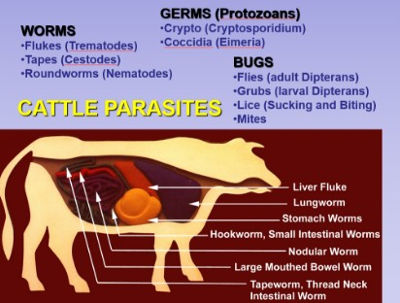By Heidi Carroll
Parasites come in many forms and impact ruminants in different ways by targeting certain areas of an animal’s body. A brief review is shown in Figure 1.

Figure 1. Categorization of common parasites impacting cattle and the main organs targeted.
Lice
More lice species are showing some level of resistance to common products. One example occurred in South Dakota where a herd of Charolais cattle had avermectin resistant long-nose cattle lice in January 2018 despite several aggressive treatments. The herd had been treated with an avermectin pour-on mid-November. Additionally, they were treated with both an avermectin pour-on and injectable mid-December after still showing infestations. In January, many lice could still be seen throughout several animals is the herd despite the previous treatments.
Treatment options for lice are dependent on the use of pesticides in three main application types.
- Sprays and dusts (fogs also): includes permethrins and malathion
- Pour-ons: includes macrocyclic lactones (avermectins and milbemycins), permethrin, insect growth regulators (IGR)
- Injectables (endectocides): includes macrocyclic lactones (avermectins and milbemycins)
Treatment recommendations are moving toward combination products that target lice in more than one stage of life, for example products like Clean-UpTM II that combines insecticide classes. Research testing different approaches to slow the development of pesticide resistance is difficult and require many years to complete, but there are statistical models that that can be used to evaluate the effects of different approaches. These models are showing that rotating insecticides and anthelmintic classes do not slow the development of resistance compared to using each class until it is not longer effective, but implementing combinations of insecticide and anthelmintics classes has been used to slow resistance to all of the classes.
Horn Flies
Another pest during summer months is horn flies (Haematobia irritans irritans). These pests aren’t just a nuisance, but they can have negative impacts on production and health of the cattle if not managed. Control or management options primarily include insecticides or physical removal of horn flies.
- Sprays both high and low pressure application
- Insecticide impregnated ear tags: organophosphates, pyrethroids, organochlorines, macrocyclic lactones
- Bags and rubs of powders
- Mineral blocks or feed additives: larvacides
- Traps
With limited new classes of insecticides being developed, management will benefit from incorporating physical removal options. Physical removal options rely heavily on fly behavior as a means to trap insects on cattle. However, training cattle to walk through and utilize traps takes time and may be a large hurdle for some animals to overcome from a behavioral and stress perspective. One example of a trap is the Bruce Walk-in Horn Fly Trap that was constructed in the 1940s.
Click here to see more...